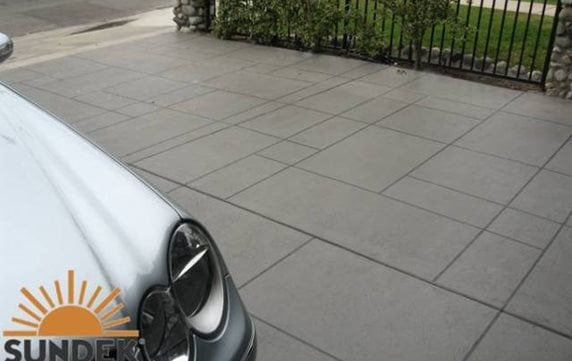Quality and Experience: Legendary Concrete Brentwood Sets the Standard
Quality and Experience: Legendary Concrete Brentwood Sets the Standard
Blog Article
The Green Choice: Concrete Sidewalks for Your Neighborhood
Choosing concrete for your area sidewalks can make a considerable distinction in terms of sustainability and eco-friendliness. Let's check out why concrete pathways could be the environmentally friendly selection your neighborhood needs.
Advantages of Concrete Sidewalks
When considering the setup of walkways in an area, the benefits of picking concrete over other materials are countless and significant. Concrete pathways offer toughness, withstanding heavy foot traffic, weather condition variations, and ecological elements better than alternative materials like asphalt or gravel. This durability equates to cost-effectiveness in the future, as concrete sidewalks call for much less constant repair work and upkeep. Additionally, concrete is a versatile material that can be easily customized to complement the aesthetic of any neighborhood through various coatings, shades, and patterns.

Longevity and Durability
Just how can concrete sidewalks outshine various other materials in terms of longevity and longevity? Concrete walkways are renowned for their exceptional sturdiness and long life contrasted to different materials like asphalt or pavers. The fundamental stamina of concrete makes it very immune to breaking, moving, and basic damage brought on by foot traffic, weather condition fluctuations, and other environmental aspects. Unlike asphalt, which can soften in heats and split in freezing conditions, concrete maintains its structural stability, needing marginal maintenance gradually.
Concrete walkways likewise have a longer lifespan than pavers, which are prone to uneven settling, weed growth in between joints, and specific paver activity. The strong, constant surface area of concrete minimizes tripping dangers and makes sure a smooth strolling path for pedestrians. Additionally, concrete's durability reduces the demand for constant fixings or substitutes, making it a economical and lasting option for area walkways. By investing in concrete pathways, areas can take pleasure in a trusted and resilient infrastructure that boosts the general aesthetic allure and performance of the location.
Low Maintenance Demands
Concrete sidewalks stick out for their minimal maintenance needs due to their sturdy nature and lasting efficiency. Unlike alternative materials that might need frequent repair work or substitutes, concrete sidewalks provide an affordable option that requires little upkeep in time. Among Bonuses the vital advantages of concrete walkways is their resistance to weathering and disintegration. This means they can stand up to harsh climate condition, hefty foot website traffic, and other environmental aspects without wearing away quickly.
Regular upkeep for concrete walkways commonly entails simple jobs such as normal cleansing to eliminate debris and periodic securing to safeguard the surface area. In comparison to products like asphalt or pavers that may shift, crack, or deteriorate more easily, concrete pathways keep their architectural stability with very little intervention. Additionally, any kind of fixings that might be needed are generally local and can be attended to quickly, decreasing both the time and price related to maintenance.

Ecological Benefits
With an emphasis on sustainability and eco-friendliness, concrete pathways click here to find out more offer notable ecological advantages that contribute to a greener area framework. Concrete is a material recognized for its resilience and longevity, reducing the demand for regular replacements. This long life reduces the environmental influence connected with the manufacturing and transportation of new products for sidewalk building and construction. Furthermore, concrete sidewalks have a high solar reflectance index, suggesting they mirror a substantial amount of sunshine rather than soaking up and keeping heat. This high quality helps alleviate the urban warmth island effect, minimizing energy usage for cooling buildings and boosting overall convenience in urban locations.
Moreover, concrete is a permeable product that permits water to penetrate right into the ground, reducing stormwater runoff and helping in groundwater recharge. This assists stop disintegration, lessen flooding, and keep the all-natural equilibrium of water supply in the area. By picking concrete pathways, areas can make a lasting selection that positively impacts the environment and enhances the lifestyle for locals.
Enhancing Neighborhood Sustainability
By prioritizing sustainable framework remedies, areas can grow an unified balance between environmental awareness and area advancement. Enhancing community sustainability includes a diverse approach that surpasses simply the ecological advantages of concrete sidewalks. Executing green rooms, advertising energy-efficient methods, and fostering a sense of area involvement are essential parts of developing a lasting community.
One way to boost community sustainability is through the integration of absorptive concrete walkways. These sidewalks permit rainwater to seep right into the ground, lowering stormwater drainage and lessening the stress on community water drainage systems. Legendary Concrete Brentwood. By integrating permeable pathways, neighborhoods can boost water high quality, decrease flooding risks, and boost overall ecological resilience
In addition, promoting alternative transport methods such as strolling and cycling can dramatically minimize carbon emissions and promote a much healthier way of life among citizens. Creating secure pedestrian pathways, bike lanes, and assigned greenways can motivate locals to count much less on autos, additionally adding to the community's sustainability objectives.
Conclusion
To conclude, concrete pathways offer many advantages for neighborhoods, consisting of toughness, low maintenance demands, and ecological advantages. By selecting concrete walkways, areas can enhance their sustainability click for more and contribute to a much more environmentally friendly atmosphere. It is clear that concrete pathways are the ideal option for communities aiming to boost their infrastructure in a environmentally friendly and long-lasting way.
When thinking about the setup of pathways in an area, the advantages of picking concrete over various other products are substantial and countless. In addition, concrete's durability decreases the need for frequent repair work or replacements, making it a sustainable and cost-effective choice for neighborhood pathways (Concrete Contractor).With a focus on sustainability and eco-friendliness, concrete sidewalks offer remarkable ecological benefits that add to a greener community facilities. Enhancing neighborhood sustainability involves a complex strategy that goes past just the environmental benefits of concrete pathways.In verdict, concrete walkways provide various benefits for areas, consisting of toughness, low maintenance needs, and ecological advantages
Report this page